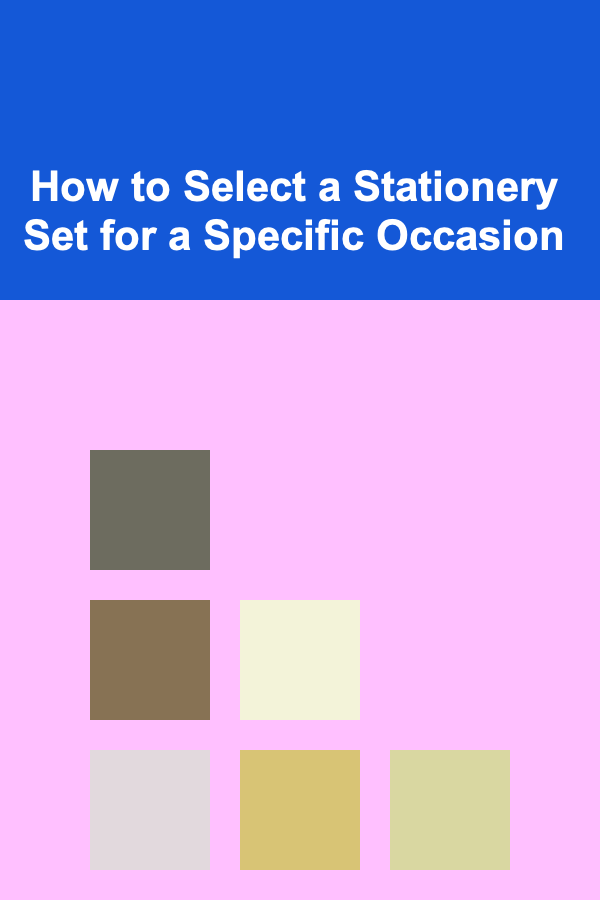
How to Select a Stationery Set for a Specific Occasion
ebook include PDF & Audio bundle (Micro Guide)
$12.99$6.99
Limited Time Offer! Order within the next:

Stationery is more than just a practical tool; it is an expression of personality, style, and the sentiment of a particular moment. Whether for personal use, professional correspondence, or a special celebration, selecting the right stationery set can enhance the message being conveyed. In this article, we will explore the various factors to consider when choosing a stationery set for specific occasions. From weddings and birthdays to corporate meetings and casual notes, the right stationery not only complements the event but also conveys the appropriate tone.
Understanding the Importance of Stationery for Different Occasions
Stationery plays a pivotal role in various life events and settings. It is often the first impression one gets of a message, a sentiment, or even a person's taste. From formal invitations to handwritten notes, the kind of stationery used sends an important signal. Choosing the right set is essential for both personal and professional reasons.
When selecting stationery, one must consider several elements such as the formality of the occasion, the medium being used (email, letter, invitation), and the recipient. The stationery chosen for a wedding, for example, will be far different from that selected for a casual thank-you note. Stationery serves as a tangible representation of the tone and nature of the communication.
Factors to Consider When Selecting Stationery
Choosing the right stationery requires attention to detail. Here are key factors to consider:
a. The Nature of the Occasion
Understanding the nature of the occasion is the first step toward selecting the perfect stationery. Each event comes with its own conventions and expectations. For example, a wedding invitation will call for a different style of stationery than a business thank-you note. Below are a few occasions and the type of stationery generally associated with them:
- Weddings: Elegant and formal stationery is typically used for weddings. Invitations are often printed on high-quality, heavy paper with embellishments like embossing, foil stamping, or intricate designs. Wedding stationery might also include save-the-date cards, RSVP cards, thank-you notes, and menus.
- Corporate Events: Professional stationery is key for corporate events, including business meetings, networking events, or conferences. Clean, minimalistic, and sophisticated designs are common, with standard colors like white, navy, black, or grey being the primary choice. Business cards, letterheads, and notepads are also common elements of corporate stationery.
- Birthdays and Anniversaries: For personal celebrations, stationery can be fun and vibrant, featuring bold colors and personalized touches. For example, a birthday card could be playful with fun fonts, bright colors, or customized photos.
- Holidays and Festivities: Stationery for holidays such as Christmas, Thanksgiving, or New Year's often includes themed designs. Cards might feature festive patterns like snowflakes, pumpkins, or fireworks, depending on the holiday. Bright colors like red, green, or gold are often used.
- Thank You Notes: Thank-you cards are personal and often intimate, with understated elegance. Simple designs like floral motifs, monograms, or minimalist lines make for perfect thank-you notes. These are often handwritten to add a personal touch.
- Sympathy and Condolences: Stationery for condolences is typically understated and respectful. Designs are usually simple, with muted tones such as white, grey, or pastel hues. Sympathy cards may also be embossed with flowers or leaves but should maintain a dignified, respectful tone.
- Casual Use: For everyday use, such as writing to a friend or family member, stationery can be more relaxed. Stationery sets may feature fun or quirky designs, colors, and fonts that reflect the personality of the writer.
b. The Tone and Style of the Event
The tone of the occasion plays a crucial role in the choice of stationery. Whether the event is formal or casual will influence your decision.
- Formal Events: For formal events like weddings, galas, or corporate meetings, the stationery should reflect the seriousness and sophistication of the occasion. Formal stationery is usually understated in design, with elegant fonts and minimal decoration. High-quality paper and printing techniques like letterpress, embossing, and foil stamping can be used for added luxury.
- Casual Events: Casual events, like a birthday party or a casual thank-you card to a friend, call for stationery that is more relaxed and lighthearted. Bright colors, whimsical fonts, and playful designs make the stationery feel more personal and approachable. Custom designs and fun patterns may be incorporated as well.
c. Personalization
Personalization adds a unique touch to any piece of stationery. Whether for professional or personal correspondence, customized stationery helps make an impression and adds meaning to the exchange.
- Custom Monogramming: One way to personalize stationery is through monogramming. Adding initials or a personal logo to stationery adds sophistication and creates a personalized and professional image.
- Customized Colors and Designs: Personalizing the design with specific colors, patterns, or motifs can align the stationery with the theme of the event or reflect the personality of the sender. For instance, a wedding invitation might feature the couple's colors, while a birthday card may reflect the favorite color of the celebrant.
- Handwritten Touch: For thank-you notes or more personal letters, handwriting always adds a personal touch. Using stationery that leaves enough room for a handwritten message ensures that the personal connection isn't lost.
d. Paper Quality and Material
The quality of paper plays a significant role in the perception of the stationery. Different occasions call for different levels of paper quality.
- High-Quality Paper for Formal Events: Weddings, corporate events, or sympathy cards often call for high-quality, thick paper. Papers like cotton or linen are typically used for formal events due to their luxurious texture and weight. Some even prefer paper with a subtle texture, such as laid paper, which adds an elegant and professional look.
- Standard Paper for Everyday Use: For casual correspondence, you may opt for more standard paper, which could be slightly thinner but still of decent quality. It could be smooth or lightly textured, depending on the style you prefer.
- Eco-Friendly Materials: Increasingly, there is a growing trend toward sustainability, and many people are opting for eco-friendly stationery. Recycled paper, plantable paper, and other sustainable materials offer an environmentally conscious option while still maintaining quality.
e. Color Scheme
The colors of the stationery should align with the overall mood of the occasion. Color psychology plays a significant role in the impact of the stationery, so it's important to choose the right colors.
- Neutral Colors for Formal Settings: For corporate events, weddings, or sympathy cards, neutral tones such as white, cream, navy, and black are preferred. These colors convey professionalism, elegance, and respect.
- Vibrant Colors for Celebrations: For birthdays, holidays, and other festive occasions, bright colors like red, orange, yellow, or green are often used. These colors evoke a sense of happiness and celebration.
- Pastels for Gentle, Personal Occasions: Soft pastel colors like light pink, lavender, or baby blue are great choices for events like baby showers, christenings, or personal thank-you notes.
f. Envelope Design and Size
Envelopes are just as important as the stationery itself, as they serve as the first thing the recipient sees. The design of the envelope should complement the stationery inside, providing a seamless experience.
- Formal Envelopes for Formal Events: For weddings and corporate events, choose envelopes that match the color and weight of the stationery. Envelopes should be properly lined and may include elegant calligraphy or a wax seal for an added touch of sophistication.
- Casual Envelopes for Personal Notes: Casual events can feature envelopes with fun patterns, bright colors, or even printed designs that reflect the occasion's theme.
- Addressing: The way the envelope is addressed is also important. For formal events, handwritten addresses with calligraphy or engraved names can elevate the look of the envelope, while printed addresses may suffice for less formal occasions.
Popular Stationery Types and Where to Use Them
a. Invitation Cards
Invitation cards are one of the most common types of stationery used for formal events like weddings, anniversaries, or corporate events. These cards set the tone for the event and provide essential details like time, location, and dress code. Invites are often paired with RSVP cards, maps, and sometimes even small keepsakes, all of which should match the same style for a cohesive look.
b. Thank-You Notes
Thank-you notes are a thoughtful way of showing appreciation for gifts, attendance, or support. Whether personal or professional, the design of a thank-you note should reflect the nature of the gift or gesture. Simple yet elegant designs work well for formal occasions, while more playful and personalized notes are ideal for casual settings.
c. Business Stationery
Business stationery includes business cards, letterheads, and note cards that are used in professional settings. This type of stationery should reflect the values and image of the company. Business cards should be clean and easy to read, with the company's logo and contact details. Letterheads are usually simple and professional, with the logo and company name prominently displayed.
d. Greeting Cards
Greeting cards are versatile and can be used for nearly any occasion. Whether for holidays, birthdays, or anniversaries, greeting cards often combine design with sentiment. They come in various formats, from blank cards that allow the sender to write a personalized message to pre-written cards with space for signatures.
Conclusion
Selecting the right stationery set for a specific occasion requires thoughtfulness, attention to detail, and an understanding of the message you wish to convey. From weddings to corporate events, personal letters to sympathy cards, the stationery you choose reflects the tone of the occasion and the emotions behind it. By considering factors such as the formality of the event, personalization options, paper quality, and design, you can make the selection process much easier and more enjoyable. Whether you choose a luxurious, professional, or playful design, the right stationery can make all the difference in creating a memorable and meaningful experience.
Reading More From Our Other Websites
- [Hiking with Kids Tip 101] Trail-End Treats: Family‑Friendly Coffee Stops Worth the Hike
- [Ziplining Tip 101] How Ziplining Gloves Enhance Safety and Performance on the Course
- [Scrapbooking Tip 101] Creative Themes to Transform Your Baby's First Year Scrapbook
- [Organization Tip 101] How to Use Pegboards for Creative Storage Solutions
- [Sewing Tip 101] Best Methods for Upcycling Old T‑Shirts into Patchwork Quilts
- [Digital Decluttering Tip 101] Tagging, Metadata, and Search: Boosting Efficiency in Cloud-Based File Organization
- [Personal Care Tips 101] How to Use Facial Cleanser for Combination Skin in Your 30s
- [Home Holiday Decoration 101] How to Decorate Your Rental Home for the Holidays: Rent-Friendly Ideas
- [Organization Tip 101] How to Customize Your Pet Area for Multiple Pets
- [Screen Printing Tip 101] Essential Tools and Materials for the DIY Screen Printer

How to Select the Best Materials for Your Renovation
Read More
How to Use Lighting to Highlight Artwork and Decor
Read More
How to Practice Contemplative Meditation
Read More
How to Clean Climbing Gear Effectively
Read MoreHow to Track Home Improvement Costs in Your Insurance Expense Tracker
Read More
10 Must-Have Items for a Grilling Checklist
Read MoreOther Products

How to Select the Best Materials for Your Renovation
Read More
How to Use Lighting to Highlight Artwork and Decor
Read More
How to Practice Contemplative Meditation
Read More
How to Clean Climbing Gear Effectively
Read MoreHow to Track Home Improvement Costs in Your Insurance Expense Tracker
Read More